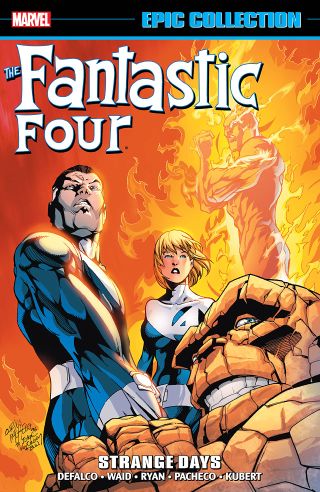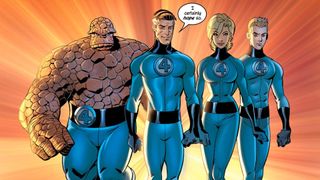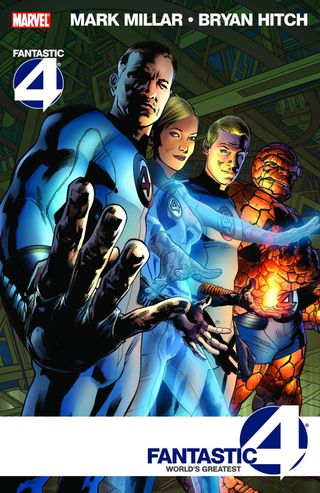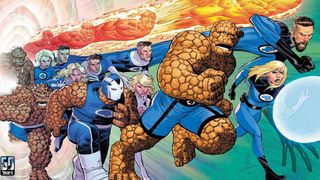The lineup of the Fantastic Four has changed over the years, but in a way it's always been the same because the ongoing Marvel series (in all its volumes) is about an extended family - the 'first family' of superheroes, the Fantastic Four.

"Everybody plays with that flexibility," says Tom DeFalco, writer of Fantastic Four from 1991 to 1996. During DeFalco's run, Mr. Fantastic — super-stretchy super-genius Reed Richards — was presumed dead for more than two years following an interstellar conflict with perennial arch-nemesis Dr. Doom.
Yet despite short-term overhauls, the series has always returned to the original four. Launched in the fall of 1961, Fantastic Four was the first team of superpowered adventurers published by Marvel Comics — appearing before Spider-Man, Iron Man, the Avengers, or the X-Men.
"There's real cachet in being the first heroes of the Marvel Universe," says Mark Waid, writer of the series from 2002 to 2005. His run on the title included the temporary death of fan-favorite character the Thing, due to the machinations of, once again, Dr. Doom.
First or not, the Fantastic Four wouldn't have lasted as long as they have if the characters weren't any good. With a team consisting of a romantic couple (Mr. Fantastic and Invisible Woman), a sibling (the Invisible Woman's younger brother, Human Torch), and their lifelong friend (the super-strong, rock-like Thing) who all gained their powers via exposure to cosmic rays during an ill-fated space expedition, 'family' has always been a key element of the comic book's dynamic.

"They were constructed to be the first family of Marvel," says DeFalco, who served as editor-in-chief at Marvel Comics from 1987 to 1994. "You had Reed, who was obviously the Father Knows Best character, Sue who was the heart of the team, Johnny the rebellious teenager, and Ben, the grumpy, angry relative."
Despite frequently encountering world-altering events, bizarre alien races, and larger-than-life threats, the grounded personalities of the Fantastic Four are frequently the main attraction of the series.
"The characters are just so vivid and the team is so well-balanced on every single level — visually, power-wise, personality-wise — that there's enough room on that team for everyone to be some reader's favorite," Waid says.
Waid, who in the past has written Captain America, The Flash, Justice League of America, and X-Men, counts guiding the Fantastic Four (along with his collaborator, late illustrator Mike Wieringo) as among his top career highlights.
"Way, way up there in at least the top five favorite assignments of all time," Waid says. "I think we succeeded often in telling the kinds of stories that weren't/aren't being told anywhere else."

Having appeared in periodicals continually for six decades, the Fantastic Four are also among the most clearly realized characters in comic books.
"You kind of can imagine what the Thing would want for dinner, or what television programs Sue Richards would watch," says Mark Millar, the writer of comic book series Kick-Ass and Wanted, both of which were made into popular feature films. "Those characters seem very, very real."
The characters of the Fantastic Four were the creation Stan Lee and artist Jack Kirby, who consecutively produced the first 102 issues of the series and introduced enduring recurring characters such as Doctor Doom, Galactus, the Silver Surfer, and the Black Panther.

"They just created something terrific there," Millar says, who wrote Fantastic Four in 2008 and launched Ultimate Fantastic Four, a modern update of the characters, along with writer Brian Michael Bendis in 2004.
Following Lee and Kirby were several subsequent acclaimed runs, from legendary comic book creators like Roy Thomas, John Buscema, Walt Simonson, and John Byrne.
"The quality is so good; I think it's probably unrivaled," says Millar, whose run on Fantastic Four included a storyline called 'The Death of the Invisible Woman,' which turned out to be a misdirect involving time travel. "If someone forced me to sit and read 500 issues of any run, Fantastic Four would probably be the one I'd enjoy most."
The characters and concepts of the Fantastic Four have frequently been adapted into other media beyond comics, most notably three big-budget live-action films. The movies were critically maligned and received a lukewarm reception at the box office, but aren't without their fans.
"I liked [the first two]," DeFalco says. "I thought they caught the characterization really well. I thought the second one was terrific, and I thought the first one had the guts of the Fantastic Four."
The team also inspired several cartoon series — as early as 1967 and as recently as 2006 — video games, a short-lived radio show starring a pre-Saturday Night Live Bill Murray as the Human Torch, and an infamous, never-officially released 1994 low-budget movie. The concept of a superpowered family has been emulated countless times in pop culture, most notably in the 2004 Pixar film The Incredibles.
Despite being one of Marvel's oldest and most prominent concepts, Fantastic Four the comic is rarely near the top of the sales charts.

"I'm not sure how relevant they are, actually," Millar says. "Other than when it first started, it never really was in the top five, in terms of sales. I wonder if it does belong to the Kennedy, space race-era."
Which might explain the tendency of writers to change what they can about Fantastic Four, all the way up to writer the recent reveal of a mystery sister for Reed Richards in Fantastic Four #35. Though the lure of the original material seems to inevitably remain strong.
"When I took over, I remember saying, ‘I'm going to try and avoid doing all the old-fashioned stuff,'" Millar said. "And then by issue 5 or 6, there was a ton of Galactus, and a ton of the old stuff. You just can't help yourself. Really, that's what makes Fantastic Four work."
Make sure you've read all of the best Fantastic Four stories of all time.

